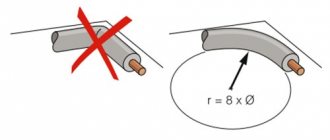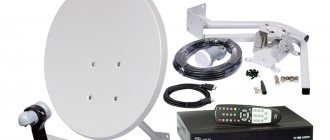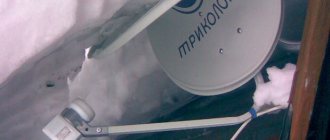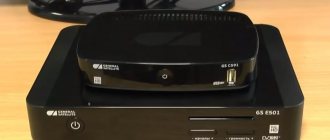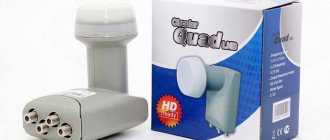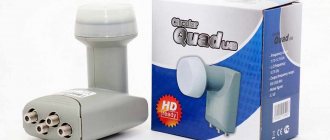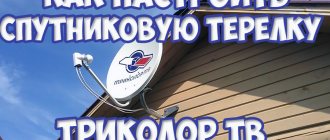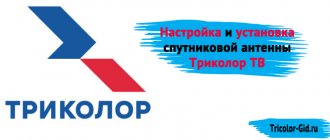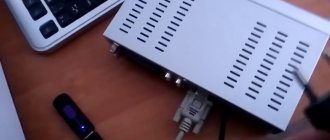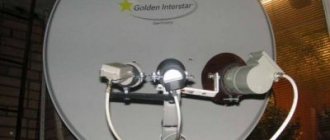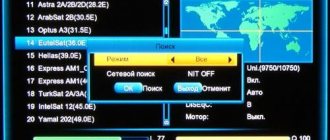The main criterion for connecting the receiver is a correctly installed and high-quality configured Tricolor TV dish. If your satellite dish is configured correctly, connecting the receiver will take you no more than 10-15 minutes.
In this article we will analyze possible schemes for connecting the Tricolor TV receiver to both a dish and a TV using examples of certain models of receivers. Receivers may differ in technical components from your receiver, but the essence of the connection always remains the same.
If you did everything according to the instructions, but there are no results, you can read the article - What to do if there is no Tricolor signal.
How to connect the receiver to the dish.
To connect the Tricolor TV receiver to a satellite dish you will need:
- 2 F connectors
- RG-6 coaxial cable
The first thing we need to do is lay the RG-6 cable from the satellite dish to the installation location of the receiver. The next step is to screw the F connectors on both ends of the cable. Let's look at a diagram of how to do this.
- Using ordinary wire cutters, we bite off the end of the cable so that it is perpendicular.
- We make a cut in the insulation 10-12 mm from the end of the cable and remove it.
- We straighten the braid and foil along the cable.
- We retreat 2-3 mm from the cable braid and remove the insulation of the central core.
- We check that the braid and pieces of foil do not touch the central core of the cable and screw the F connector until it stops.
The next step is to screw one end of the cable to the receiver in LBN in and the other end to the converter on the satellite dish. Carefully, without knocking down the plate, secure the cable to the antenna with ordinary construction ties or electrical tape.
Selecting a cable for a satellite dish
Here we will talk a little about choosing a cable. Several main criteria in its selection.
To connect the satellite antenna to the receiver, an (HF) coaxial cable is used, used for satellite and terrestrial television; its characteristic impedance is usually 75 Ohms
.
Coaxial cable
- designed to protect the electrical signal passing in this cable from the effects of external electromagnetic waves (electromagnetic interference from electrical appliances, power lines, radio-electronic devices, etc.).
A coaxial cable consists of an outer and inner conductor, which are insulated with each other by a dielectric polymer, and also have an outer insulating sheath.
The inner conductor is usually made of copper or aluminum alloy, but can also be made of other composite alloys (silver-plated, copper-plated, gold-plated, etc.).
The outer conductor is made of foil and braid, which serve as protection from the effects of the electromagnetic field created by other power sources. The outer conductor braid can be made of either aluminum or copper alloys.
One of the main indicators when choosing a cable for a satellite dish is the attenuation of the signal (characteristic impedance) transmitted along the central conductor. Signal attenuation directly depends on the material from which the coaxial cable is made. For example, the attenuation in a cable made of copper alloys will be several times less than in a cable made of aluminum alloys.
The middle core inside the coaxial cable should preferably be copper. In some brands, copper is sprayed onto aluminum or onto a steel core.
It is advisable that the cable insulation is not very hard, as in cold weather it will crack easily.
And also, check if the cable itself is old. For example, lying somewhere in a cold warehouse for years like that... tsat. To do this, use your fingernail to pick at the very tip of the cable its outer insulation; it should not stick to the shielded braid.
We should not forget that even minor damage to the cable sheath over time can lead to major problems in the operation of the receiving equipment and switching components of the wiring.
Examples of deformation when bending cables of different prices and quality
| When bent, the cable bends at an acute angle, which is fraught with increased losses. The shell is too soft and lags behind the central dielectric |
| When bent, the cable bends at an angle, which can increase losses. Although less than in the first version. The shell is soft and lags behind the central dielectric |
| The fold line is rounded. There will be no losses. The shell is moderately elastic and dense, fits well to the internal dialectric. |
When using a cable that is not suitable for its parameters in the winter (and this is a significant part of the year in our country), it receives damage in the form of external and internal cracks in the sheath, sometimes invisible at first glance. Subsequently, these cracks increase due to temperature fluctuations, wind loads, etc.
In winter there will be no special problems, since the air is dry, but when spring comes, water begins to enter these cracks and destroys the internal structure of the cable, significantly worsening its electrical parameters. Failures begin when switching channels (from lower to upper range and vice versa, switching polarization, operation of discs and splitters, motorized suspensions and multiswitches).
And the most unpleasant thing happens when water penetrates the receiver’s tuner through the cable and damages it. In this case, as a rule, the repair consists of replacing the receiver, or long-term and expensive repairs.
To better understand the internal structure of such a cable (standard version), take a look at the figure below (Fig. 1) .
Rice. 1 Structure of coaxial high-frequency cable.
As you can see, a standard cable consists of five elements:
1 — the main copper core, through which, in relation to the braid and foil (used as a housing or a common wire), the converter’s power will flow in one direction, and the high-frequency signal in the other;
2 - the internal insulator, the combination of the diameter of the main core and the diameter of the insulator determine the characteristic impedance of this cable, which in our case should be 75 Ohms;
3 — aluminum foil, which serves to improve shielding properties;
4 — metal braid, i.e. body;
5 - external insulation, the purpose of which will be to protect the entire cable from environmental influences.
Depending on the type and manufacturer, the cable structure may be different. To reduce the cost of the cable, the middle core may not be copper, but from another alloy, with a thin layer of sputtering of the same copper (Fig. 2) . Electrical parameters do not deteriorate with such deposition, since the high-frequency signal tends to pass not inside the conductor, but along its surface, but... if the deposition layer is very thin, or not uniform, then with a more significant bend in the cable, such a layer may simply crack, and this may interfere with the signal. So, it is advisable to buy a cable with a copper middle core. Also, it would be nice if the braid and foil were also copper. But, such brands of cable, as a rule, will cost much more.
Rice. 2 Structure of the copper-clad middle core of a coaxial cable.
But no matter how different the cable structure is, the operating principle remains the same. And it consists in shielding the middle core of this cable from external electrical interference, without disturbing the wave impedance (75 Ohms).
Satellite TV equipment usually comes with an RG-6 cable from Chinese or Russian manufacturers, which is based on a copper-plated central conductor and an aluminum screen braid.
If, when installing satellite equipment, the distance from the satellite antenna converter to the receiver (receiver) is no more than 30 m, then you can safely use this cable to connect the purchased equipment.
To connect a satellite dish over longer distances, it is recommended to choose a cable with better characteristics. For example, a cable from Italian brands: SAT-50 or SAT-703.
If, when laying a cable, it is necessary to run a significant distance in the open air, you need to choose a cable that is more resistant to atmospheric changes, for example, CAVEL DG 113PEM.
To connect such a cable, special “connectors” are used, which you will also have to buy. They are not expensive, so buy a dozen of them so that you don’t have to worry about the little things.
Connectors F-connectors
Before buying the cable we need, we must, of course, find out how long it will be. To do this, let’s take a tape measure in our hands and measure the places through which our cable will pass, starting from the converter and ending where the satellite receiver will be located.
When purchasing a coaxial cable, take one connector with you and check in the store whether the cable and connector are suitable in diameter. To do this, taking the end of the cable in your left hand, screw the connector onto the cable with your right hand (for this purpose, there is a thread cut inside the narrow part of the connector), and it should be screwed on quite tightly. Otherwise, if the connector on the cable dangles, you can forget about good contact (I had such cases, and at the same time, I had to increase the thickness of such a cable with a piece of foil).
Laying and installation of TV cable
How to connect the receiver to the TV.
The method of connecting the Tricolor TV receiver directly depends on your TV. There are 3 main types of connecting the receiver to the TV, let's look at them.
- The first is connection via the built-in RF modulator (for older models of receivers).
The essence of this connection is that your receiver converts the video signal to analog and is transmitted to the TV via a regular coaxial cable. For this connection, your receiver must have an RF OUT output.
In practice, such a connection is used in public places, such as shopping centers, cafes, where you need to connect many televisions with the ability to watch one channel selected on the satellite receiver.
For example, if the Russia24 channel is selected on the receiver, then the Russia24 channel will be shown on all TVs.
To connect in this way, you just need a regular TV cable. You insert one end of the cable into the receiver (RF OUT), insert the other end into the TV (ANT in), and then start auto-tuning channels on your TV. Your TV will find one analog channel, where your video signal from the Tricolor receiver will be located.
The main thing is to remember the channel number on a TV with a Tricolor signal and no longer switch programs from the TV remote control; now you will control your channels from the remote control from your receiver.
If you do not have a built-in RF modulator in the Tricolor TV receiver and you are comfortable watching the same channel on all TVs at the same time, then you can purchase an RF modulator and split the signal using a splitter with a number of outputs corresponding to the number of your TVs.
- Connecting the Tricolor TV receiver to a 3RCA or SCART TV. This type of connection is mainly used for older TVs that do not have an HDMI input.
- Connecting the Tricolor TV receiver using an HDMI cable. With this connection you will achieve high quality on your TV, this applies not only to the picture, but also to the sound. All modern TVs are equipped with HDMI inputs.
Tips for use
To avoid premature wire failure, adhere to the following recommendations:
- When choosing an antenna cable to your TV for residential connection, you should buy a model with high wave capacity.
- For outdoor installations in regions with extreme weather conditions (abnormal heat, excessive temperature fluctuations, increased precipitation, too low temperatures), choose wires with special impregnation.
- During the installation process, you should not make too many solders and connections, as this will negatively affect the quality of the signal. Laying a single wire is the optimal solution.
- You should not use home-made splitters; it is more advisable to acquire a proprietary device. In addition, splitters and signal amplifiers should be located in accessible places - it is possible that a breakdown will occur over time, and repairs will be carried out accordingly.
- During the installation process, follow the manufacturer's recommendations. This is especially true for the bending radius and the distance between fasteners.
- Under no circumstances should a coaxial cable be laid close to electrical appliances - this may cause interference.
The expert advice offered will help you make the right choice. As a result, you will achieve the highest possible quality of connection to television equipment.
How to connect the receiver to 1 TV
Using the example of the GS E521 L receiver with the ability to connect a second receiver
We screw the cable coming from the satellite dish to the LBN in 1 connector.
We connect the receiver to the TV using an HDMI or 3RCA cable, depending on the availability of the corresponding connectors (to achieve the best quality, it is worth connecting with an HDMI cable).
Having connected them together, select the appropriate input to which you connected your TV (you can find out by looking behind the TV, all connectors are labeled and numbered. Example: HDMI 1, HDMI 2 or AV 1) using the television remote control.
On the screen you will see the initial setup of the receiver; after completing it and saving the found channels, you can start watching satellite television.
After setting up, you may need to register; you can do it yourself on the website www.tricolor.tv in the “subscriber registration” column.
How to connect two TVs to Tricolor TV.
Using the example of the GS E521L/GS C5911 receiver
Method No. 1 (using a UTP network cable)
We connect two cables coming from the Tricolor satellite dish to LBN in 1 and LBN in 2.
If it is not possible to extend two cables from the antenna to the E521L server, then you can use a jumper between the LBN 1 out and LBN 2 in contacts (with such a connection, there will be slight losses in the number of channels on the second C5911 receiver).
You can make a jumper from a piece of regular RG-6 coaxial cable by screwing F connectors on both sides. We connect the receiver using an HDMI or 3RCA cable (if the TV has both inputs, then the HDMI connection is preferred).
We select the video input we need on the TV, for example HDMI 1, after which you will see the initial settings on your screen. You can find how to make the initial settings in the “user manual” book included in the kit.
The next step is to connect the E 521L server and the additional C 5911 set-top box; for this we will need a crimped UTP network cable. Using a UTP cable, we connect the receivers to each other by inserting the ends of the cable into the ETHERNET connectors. We connect the additional C 5911 set-top box to the TV using HDMI or 3RCA. As on the first TV, select the appropriate video input and perform the initial settings.
To connect to the server, in the “network settings” item you need to select the server, if the connection is correct, it will appear automatically in the 2nd column, select it and click “search”. In some cases, after the receivers are fully connected, you will need to update the receivers' software. The update should be carried out from the additional set-top box C 5911, setting channel No. 333 “telemaster” and wait 5-10 minutes. During this time, a column with a request to update the software will appear on the screen, press the “OK” button and wait for the update to complete. It is very important not to turn off the power during the update!
Method No. 2 (using a Wi-Fi router)
The difference between the connection in scheme No. 2 and scheme No. 1 is the ability to watch your favorite channels on a tablet or mobile device. To do this, we connect the receivers through a router by setting the appropriate parameters in the initial settings of the receivers in the “network setup” item. To watch Tricolor TV on a tablet or mobile device, you need to download the “Play.Tricolor” application. Connect to the Wi-Fi network of your router and set the appropriate settings on your device in the “Play.Tricolor” application.
The main criterion for connecting the receiver is a correctly installed and high-quality configured Tricolor TV dish. If your satellite dish is configured correctly, connecting the receiver will take you no more than 10-15 minutes.
In this article we will analyze possible schemes for connecting the Tricolor TV receiver to both a dish and a TV using examples of certain models of receivers. Receivers may differ in technical components from your receiver, but the essence of the connection always remains the same.
If you did everything according to the instructions, but there are no results, you can read the article - What to do if there is no Tricolor signal.
How to connect the receiver to the dish.
To connect the Tricolor TV receiver to a satellite dish you will need:
- 2 F connectors
- RG-6 coaxial cable
The first thing we need to do is lay the RG-6 cable from the satellite dish to the installation location of the receiver. The next step is to screw the F connectors on both ends of the cable. Let's look at a diagram of how to do this.
- Using ordinary wire cutters, we bite off the end of the cable so that it is perpendicular.
- We make a cut in the insulation 10-12 mm from the end of the cable and remove it.
- We straighten the braid and foil along the cable.
- We retreat 2-3 mm from the cable braid and remove the insulation of the central core.
- We check that the braid and pieces of foil do not touch the central core of the cable and screw the F connector until it stops.
The next step is to screw one end of the cable to the receiver in LBN in and the other end to the converter on the satellite dish. Carefully, without knocking down the plate, secure the cable to the antenna with ordinary construction ties or electrical tape.
How does a television wire work?
First, a little theory that will help you better navigate the issue and not follow the lead of the consultants in the store.
In terms of design, all cables have a similar structure:
- central vein;
- insulation layer;
- shielding layer;
- braid;
- protective shell.
The differences lie only in the quality and type of materials used. Cables of this type are called “coaxial” by experts.
The central core of the cable is intended for signal transmission (any type of television). It also serves as a power conductor for converters in satellite TV. The core is made either of pure copper or steel wire protected by a copper coating.
Cables with a central copper core are only required when connecting satellite TV. In all other cases, metal cores also function perfectly. For this reason, they are the most common because they have a more affordable price.
The cable shield and braid are designed to protect the signal from a variety of interference. The shielding is made of aluminum-based foil. The braid can be made from the following wire:
- aluminum;
- copper;
- copper with tinning.
A protection rating of 60 dB is average; over 90 dB guarantees high-quality shielding. It is worth noting that reception reliability largely depends on how well the screen and braid were made.
The insulation layer covering the central core protects it from damage and prevents short circuits between the screen and the braid. The outer contour shell is made of PVC, protecting it from negative environmental factors and mechanical damage.
How to connect the receiver to the TV.
The method of connecting the Tricolor TV receiver directly depends on your TV. There are 3 main types of connecting the receiver to the TV, let's look at them.
- The first is connection via the built-in RF modulator (for older models of receivers).
The essence of this connection is that your receiver converts the video signal to analog and is transmitted to the TV via a regular coaxial cable. For this connection, your receiver must have an RF OUT output.
In practice, such a connection is used in public places, such as shopping centers, cafes, where you need to connect many televisions with the ability to watch one channel selected on the satellite receiver.
For example, if the Russia24 channel is selected on the receiver, then the Russia24 channel will be shown on all TVs.
To connect in this way, you just need a regular TV cable. You insert one end of the cable into the receiver (RF OUT), insert the other end into the TV (ANT in), and then start auto-tuning channels on your TV. Your TV will find one analog channel, where your video signal from the Tricolor receiver will be located.
The main thing is to remember the channel number on a TV with a Tricolor signal and no longer switch programs from the TV remote control; now you will control your channels from the remote control from your receiver.
If you do not have a built-in RF modulator in the Tricolor TV receiver and you are comfortable watching the same channel on all TVs at the same time, then you can purchase an RF modulator and split the signal using a splitter with a number of outputs corresponding to the number of your TVs.
How to connect the receiver to 1 TV
Using the example of the GS E521 L receiver with the ability to connect a second receiver
We screw the cable coming from the satellite dish to the LBN in 1 connector.
We connect the receiver to the TV using an HDMI or 3RCA cable, depending on the availability of the corresponding connectors (to achieve the best quality, it is worth connecting with an HDMI cable).
Having connected them together, select the appropriate input to which you connected your TV (you can find out by looking behind the TV, all connectors are labeled and numbered. Example: HDMI 1, HDMI 2 or AV 1) using the television remote control.
On the screen you will see the initial setup of the receiver; after completing it and saving the found channels, you can start watching satellite television.
After setting up, you may need to register; you can do it yourself on the website www.tricolor.tv in the “subscriber registration” column.
Optimal solution
As an optimal option, we can recommend the middle price segment (SAT 50, SAT 703). Such conductors have a fairly high quality of performance and good performance in signal transmission.
Budget models (RG-6, RK 75, RG 59) are suitable for laying lines over short distances under normal conditions. More expensive models (DG 113) are used where it is necessary to ensure the best signal quality and maximum protection.
How to connect two TVs to Tricolor TV.
Using the example of the GS E521L/GS C5911 receiver
Method No. 1 (using a UTP network cable)
We connect two cables coming from the Tricolor satellite dish to LBN in 1 and LBN in 2.
If it is not possible to extend two cables from the antenna to the E521L server, then you can use a jumper between the LBN 1 out and LBN 2 in contacts (with such a connection, there will be slight losses in the number of channels on the second C5911 receiver).
You can make a jumper from a piece of regular RG-6 coaxial cable by screwing F connectors on both sides. We connect the receiver using an HDMI or 3RCA cable (if the TV has both inputs, then the HDMI connection is preferred).
We select the video input we need on the TV, for example HDMI 1, after which you will see the initial settings on your screen. You can find how to make the initial settings in the “user manual” book included in the kit.
The next step is to connect the E 521L server and the additional C 5911 set-top box; for this we will need a crimped UTP network cable. Using a UTP cable, we connect the receivers to each other by inserting the ends of the cable into the ETHERNET connectors. We connect the additional C 5911 set-top box to the TV using HDMI or 3RCA. As on the first TV, select the appropriate video input and perform the initial settings.
To connect to the server, in the “network settings” item you need to select the server, if the connection is correct, it will appear automatically in the 2nd column, select it and click “search”. In some cases, after the receivers are fully connected, you will need to update the receivers' software. The update should be carried out from the additional set-top box C 5911, setting channel No. 333 “telemaster” and wait 5-10 minutes. During this time, a column with a request to update the software will appear on the screen, press the “OK” button and wait for the update to complete. It is very important not to turn off the power during the update!
Method No. 2 (using a Wi-Fi router)
The difference between the connection in scheme No. 2 and scheme No. 1 is the ability to watch your favorite channels on a tablet or mobile device. To do this, we connect the receivers through a router by setting the appropriate parameters in the initial settings of the receivers in the “network setup” item. To watch Tricolor TV on a tablet or mobile device, you need to download the “Play.Tricolor” application. Connect to the Wi-Fi network of your router and set the appropriate settings on your device in the “Play.Tricolor” application.
Tricolor is on the list of providers that offer citizens to connect to satellite television. Many people are interested in how to independently connect Tricolor TV to a TV without calling a technician to their home.
Choosing a cable for the main types of TV
There are several modern types of television broadcasting, ranging from terrestrial to satellite. The last type of TV will be discussed separately; as for the others, it makes no sense to select a cable separately for each type.
The broadcast frequency of cable channels, digital and terrestrial TV is in a fairly narrow range from 40 to 800 MHz. It is perfectly covered by all the listed brands. With a conductor length within 30 m, the loss of quality is almost unnoticeable even in inexpensive models. For this reason, you can safely purchase one cable for any television except satellite.
What is included in the Tricolor kit
The company produces several types of equipment and offers different tariff plans. Buyers can choose sets for standard and smart TVs.
Most of the kits are equipped with receivers; there are also devices with a CAM module. If we talk about the standard set, it includes the following:
- CAM module. It is compatible with television receivers that support the satellite TV standard. This is DVB-S2.
- Smart card. It is necessary for the TV.
- Satellite dish.
- A receiving device called a satellite circular converter.
To connect television it is not necessary to purchase a complete set of equipment. It is enough to buy a smart card and then enter into an agreement with the service provider.
Choosing a cable for satellite TV
What kind of cable is needed for a satellite dish? The frequency of satellite channels plays a big role here; they are higher and the measurement takes place in thousands of megahertz. It is important to achieve transmission without significant loss of quality.
It is worth adding to this that the cable transmits special impulses and through it power is supplied to the converter. The quality loss of the satellite signal increases rapidly as the conductor lengthens. It is also quite sensitive to external interference.
For this reason, special requirements are placed on conductors for satellite TV. Only models SAT 703, DG 113 or similar characteristics can provide proper transmission conditions.
The general requirements for a cable for receiving satellite TV are as follows:
- the main core is made of copper;
- low signal attenuation;
- high quality outer shell.
Connecting Tricolor TV to a TV: detailed instructions
Tricolor TV is installed when there is a desire to choose programs from more than a hundred channels. Thanks to the satellite dish, users receive high-definition images.
The plate is fixed on the roof of the building or the wall of the building. Additionally, a converter is installed; a tuner is needed for operation. The device is connected to the equipment. Users are often interested in how many TVs can be connected. If necessary, you can connect several devices to one antenna, for example, 4 pcs.
In order to watch TV channels, the receiver is connected to an antenna. To do this, use the holes located on the equipment.
Users are often interested in how to connect the Tricolor receiver to a TV.
There are different connection methods:
- RF. This option was used when there were old TVs and, if necessary, installing an indoor or outdoor antenna.
- AV. It can be found on all devices. Using a multi-colored cable, the receiver is connected to the old equipment.
- S-Video. It is needed to connect the system unit with a mouse or keyboard. This element is designed to complement modern receivers or the latest models of equipment.
- YPbPr. It is necessary in order to be able to transmit images in 1080i resolution. In this case, several cables are used, each of them has its own color.
- HDMI. It allows you to show the picture as the operator broadcasts it. No changes or transformations occur in this case.
The company has set a goal to gradually switch to HDMI, this will allow all connected users to view clear images in HD format.
If you are wondering how to connect the Tricolor receiver to your TV, you can follow these steps:
To connect the antenna you need to do the following:
- Take a coaxial cable.
- Expose the core in the center. To do this, you need to unscrew the braid.
- You need to take connector F and connect to the 2 ends of the wire.
- Connect to the antenna.
- The second end is connected to the LBM in receiver input.
- The cable is fixed on the plate.
When the work is completed, check the reliability of the connection of all elements. The quality of the received signal depends on this.
At the second stage, the plate is connected to the equipment. First, the set-top box is checked to make sure there are outputs. To connect to the converter use LNB in. The socket through which you can connect an antenna is labeled LNB out.
Depending on what type of receiver is used, the set of connectors changes. It is useful to make sure that the firmware version is up to date. In this case, the picture can be broadcast to all outputs. But there are situations when users will have to choose which output to send the signal to.
You need to insert a high-frequency cable into the LNB out connector; as a result, an antenna will be connected. The receiver and TV will turn on, you will see the word Boot on the monitor, after which the channel number will become visible.
The TV owner needs to complete the setup, and then wait until the “No Signal” message becomes visible. Its appearance will mean that all operations were performed correctly. The remaining cables are connected in the same way and configured.
If there is an old TV in the room, but the owner decided to connect it, then for this you will need a “tulip”. It has 3 outputs, each marked with its own color. But this option has disadvantages; it will not be possible to transmit the image in high quality.
Since 2021, television channels began to be displayed in the lists, this was done for the convenience of users. If you need to set up Tricolor TV channels, the step-by-step instructions are as follows:
- You need to turn on the TV, and then switch it to a mode that allows you to configure satellite channels. To do this, you need to select the antenna settings section in the menu.
- Select the “Manual setting” menu item.
- Before you start searching for channels, you need to make sure that the manual mode parameters are set: Network Search is enabled (this option is responsible for network search). Set the transponder frequency, select the symbol rate and satellite. The values should be 12226, 27500 and Eutelsat 36E.
- How to set up Tricolor channels is written in the instructions. You need to start searching for channels, and then perform the actions that will be written on the TV screen. During the process, data will be displayed about how the search is progressing and what channels are found.
- When the search is completed, the TV owner must save the channel list.
When searching for channels, if the settings do not contain the necessary data, you can enter it manually.
How to connect Tricolor to 2 TVs
If you need to connect 2 television receivers to Tricolor, you need to do the following:
- Connect all equipment into one network. If an antenna has not been installed, this must be done.
- Connect the main receiver, television.
- When the first TV starts showing a picture, set up the second one in the same way.
You will not have to perform any additional operations. If everything is done correctly, the equipment will configure itself and the owner’s intervention will not be required.
Many people are interested in how to connect a second TV to Tricolor TV without a second receiver. This can be done without additional equipment, but in this case there will be inconvenience. The image on each TV will be the same, so you won’t be able to watch different programs at the same time.
If someone is satisfied with this situation, you can connect the Tricolor dish. In this case, the connection diagram is as follows: the connection is made through the connectors located on the rear panel of the equipment.
TVs are connected to a set-top box; different cables are used for this. You can also buy a splitter in the store, with its help you can simultaneously transmit a signal to 2 devices. But you need to take into account that installing such equipment can affect the quality of the picture.
